February 10, 2023
Today in Microsoft Flight Simulator, I’ll be flying the Curtiss JN-4 “Jenny”, the first mass-produced aircraft in America and a favorite of the old-time “barnstormers”.

And to help frame the story, I’m at a small dirt airstrip outside of Americus, Georgia in May 1923, where a 21-year-old Charles Lindbergh is buying his first plane – a war surplus Jenny – for $500.

The story of the Jenny begins around 1900 in upstate New York, with a young bicycle racer named Glenn Curtiss.

Bicycles were the new rage, but Curtiss felt the need for even more speed. He designed his own light-weight engines to attach to his bicycles to turn them into motorcycles. In 1907, he set the land speed record of 136 mph on a beach in Florida.

Curtiss’ light-weight but powerful engines attracted the attention of “Colonel” Tom Baldwin, who had a traveling show where he flew – and parachuted from – balloons before astonished crowds. In 1904, Baldwin flew his new airship “The California Arrow” at the St. Louis World’s Fair, powered by a Curtiss engine.

After unconfirmed reports of the Wright Brothers’ first flight in December 1903, Curtiss was invited by the renowned telephone-inventor Alexander Graham Bell to join his Aerial Experiment Association (AEA), a hand-picked group of experts working on the problem of flight.

As part of this group, Curtiss designed the “June Bug”. On July 4, 1908, he flew it before an Independent Day crowd at Hammondsport, New York for a distance of 5,090 feet – the very first public demonstration of an airplane in the U.S. (the Wrights, until then, had kept their flights strictly hush-hush as they pursued a patent).

The Wright Brothers soon sued Curtiss, accusing him of infringing on their patents. Despite this ongoing and bitter battle, which lasted many years, Curtiss continued to develop and fly new airplanes, breaking new ground (including the first cross-country flight, from Albany to New York City, and the first plane to take off and land on water).

While the legal battles raged on, hampering U.S. aircraft production, Curtiss was eagerly taking lessons from the rapid wartime development of aircraft in Europe during World War I. When the U.S. military began putting out requests for an airplane to train new pilots, Curtiss was ready.
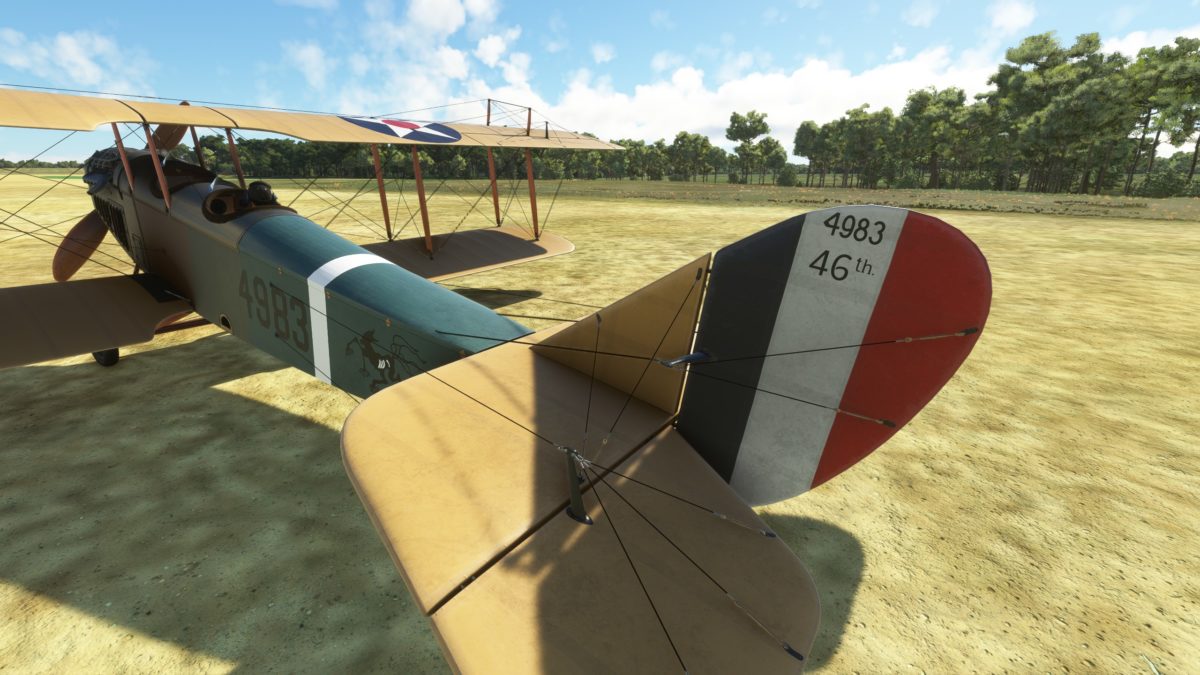
Curtiss was an adaptive implementor and improver, not a visionary inventor. His series of trainers, which culminated in the JN-4, was based on designs derived from the war in Europe.

The wings and fuselage are constructed of a wood and wire frame covered with doped (painted) fabric.

With a wingspan of almost 44 feet (compared to a length of 27 feet), the Jenny biplane was all but a kite.

These large lifting surfaces were necessary because of all the drag created by the many control and bracing wires, holding up the wing and operating the ailerons.

The engine, a Curtiss OX5 V-8 air-cooled piston engine, looks powerful but only delivered a modest 90 horsepower, half that of a Cessna 172, and less than most biplanes of its era.

Designed as a trainer, the Jenny had two cockpits, the forward one for the student (or passenger) and the rear for the instructor (or solo pilot).

The instrument panel is extremely rudimentary: an altimeter in the center. To the left, engine temperature and fuel cutoff. To the right, an oil gauge and tachometer (for engine RPM). No airspeed indicator or anything to indicate the airplane’s direction or orientation. No compass either.

The lever to the left engages the magneto, the generator that ignites the spark plugs when the propeller turns.

To the right is the throttle, to control the flow of air into the engine, and with it the pace of combustion. No fuel mixture control, much less a propeller pitch control. Two batteries are stowed on the shelf under the instrument panel.

Just outside the cockpit, an arm’s length away, is a fire extinguisher.

The fuel gauge is straight ahead, over the engine, and it currently shows full.

The ailerons and elevators are control with a stick, and the rudder with a wooden foot bar. Both are connected via cables and pulleys directly to the control surfaces. (The same is true in a Cessna 172 today, the wires just aren’t as visible.)

Here’s a view of the front cockpit for the student or passenger, which has all the controls but no instruments besides an oil gauge.

The son of a Congressman, young Charles Lindbergh knew how to a fly a plane – sort of. After quitting college, he had taken flying lessons in Nebraska. But the instructor hadn’t let him solo, because he couldn’t post the required damage bond.

So Lindbergh, known by his nickname “Slim”, had traveled around the country, working as a mechanic, wing-walker, and parachutist for other pilots performing as barnstormers, until he saved up enough money to come here, to a former wartime training base in Georgia, to buy one of its leftover Jennies.

Here’s how that scene was portrayed in the 1957 bio-pic “The Spirit of St. Louis”, with Jimmy Stewart playing Lindbergh. I can’t vouch for its accuracy.
As the film clip shows, the way to start a Jenny was to turn on the magneto (“Contact!”) then have someone spin the propeller to get the generator going, which would engage the spark plugs and start the engine.

Lindbergh actually spent about five hours practicing solo around Americus before heading off on his first cross-country flight, which I’ll reenact as a way of getting acquainted with the Jenny.

That first flight took him from Americus to Montgomery, Alabama, about 140 miles to the northwest – close to the Jenny’s maximum range. I’m not sure whether he had a plan, or just flew until he ran out of gas.

There were no highways at the time, and certainly no radio beacons to follow. So I strongly suspect he followed the railroad line from Americus to Columbus, Georgia and then onto Montgomery, which is what I’m doing here.

The maximum speed of the Jenny is 75 mph (65 knots), and a more typical cruise speed is just 60 mph (52 knots). That’s barely sufficient takeoff speed for a Cessna 172.

At that rate, it takes about an hour to reach Columbus, and over another hour to reach Montgomery – assuming no headwind.

With no way to adjust fuel mixture for air density, the operating ceiling of the Jenny is just 6,500 feet above sea level. I’ve found it’s not very easy to coax it above 3,000 feet.

The wings really are like kites, and I’ve found that a strong gust will knock me for a tilt very easily. The plane takes constant inputs to correct and stay straight and level.

Despite having no compass, I’ve been able to follow the railroad tracks to Columbus, along the Chattahoochee River. During the Civil War, it hosted an important shipyard for the Confederate Navy.

Not quite a year after acquiring his Jenny, Lindbergh reported for duty for military flight training with the U.S. Army Air Service in San Antonio, Texas.

The first Jennies, actually JN-3s, were delivered to the U.S. Army in March 1916, and deployed here, at Columbus, New Mexico near the Mexican border.
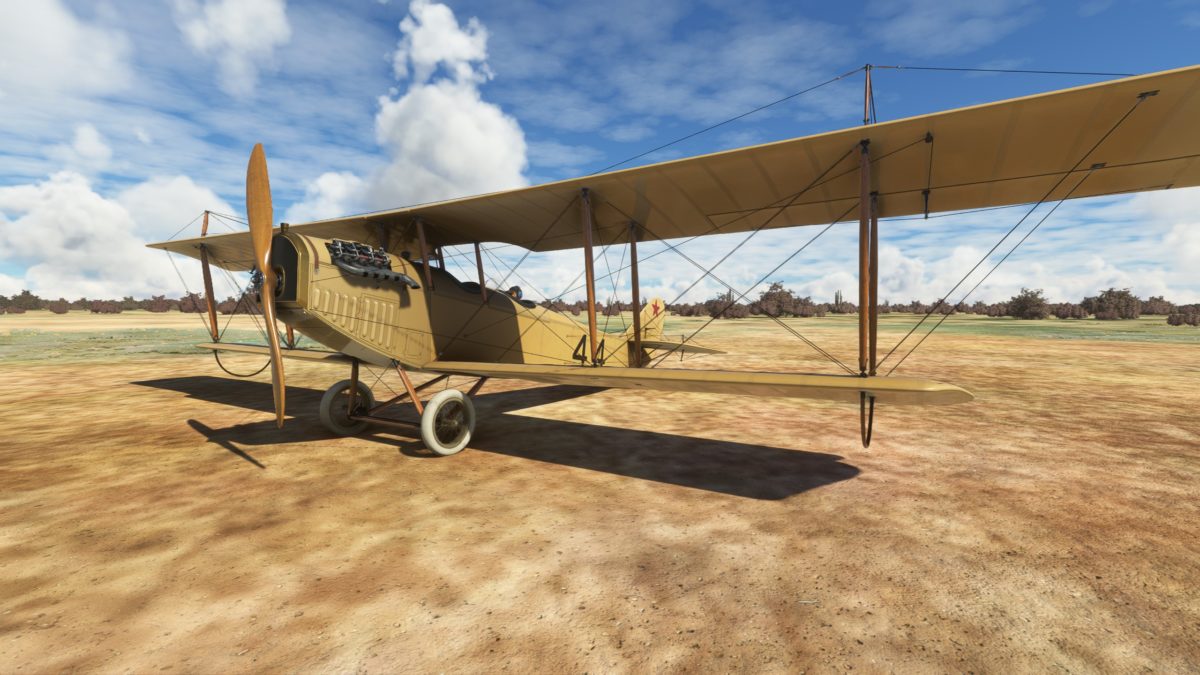
Just a few weeks earlier, Columbus had come under attack by the Mexican revolutionary Pancho Villa. His men burned the town, killed 10 civilians and 8 soldiers, and stolen horses and machine guns before escaping back over the border into Mexico.

In response, President Woodrow Wilson mobilized 10,000 troops under the command of Brigadier General John J. Pershing to pursue Villa.

They were joined by the 1st Aero Squadron, one of whose Jennies I’m flying right now.

Their job was to search out signs of Villa’s forces, and to carry orders and reports to and from the different columns of U.S. troops spread out across the remote deserts of northern Mexico.

It proved a difficult task. The Jenny couldn’t climb over mountains in Mexico’s rough terrain. They got lost at night. Dust storms led to mechanical breakdowns. The desert heat destroyed the lacquer coating on their propellers. By the end of the first month, only two planes were still airworthy.

In the end, U.S. troops never were able to capture Pancho Villa, though they did dispersed his forces and prevent further cross-border raids.

And despite their shortcomings, the Jennies did give the U.S. Army its vital baptism in aerial operations.

Here’s one of those Jennies that took part in the Pancho Villa Expedition, on display at the Frontier Army Museum at Fort Leavenworth, Kansas.

The 1st Aero Squadron still exists, by the way – only today it flies U-2 spy planes and drones.

As the war in Europe continued, and the U.S. grew ever closer to being drawn in, thousands more JN-4 Jennies were delivered to airfields across the country for their primary purpose: teaching new pilots to fly.

This particular Jenny was assigned to the Air Service Mechanics School at Kelly Field, just outside of San Antonio, Texas – one of the airfields where Lindbergh later trained.

Kelly Field is still an active installation today, adjacent to Lackland Air Force Base. Its modern 11,550-foot runway, fit for C-5 Galaxy cargo jets, utterly dwarfs the tiny Jenny.

Kelly Field was named for 2LT George Kelly, who on returning to San Antonio after learning to fly at the Curtiss Aviation School in California, crashed and was killed while attempting to land – a not uncommon fate among early aviators.
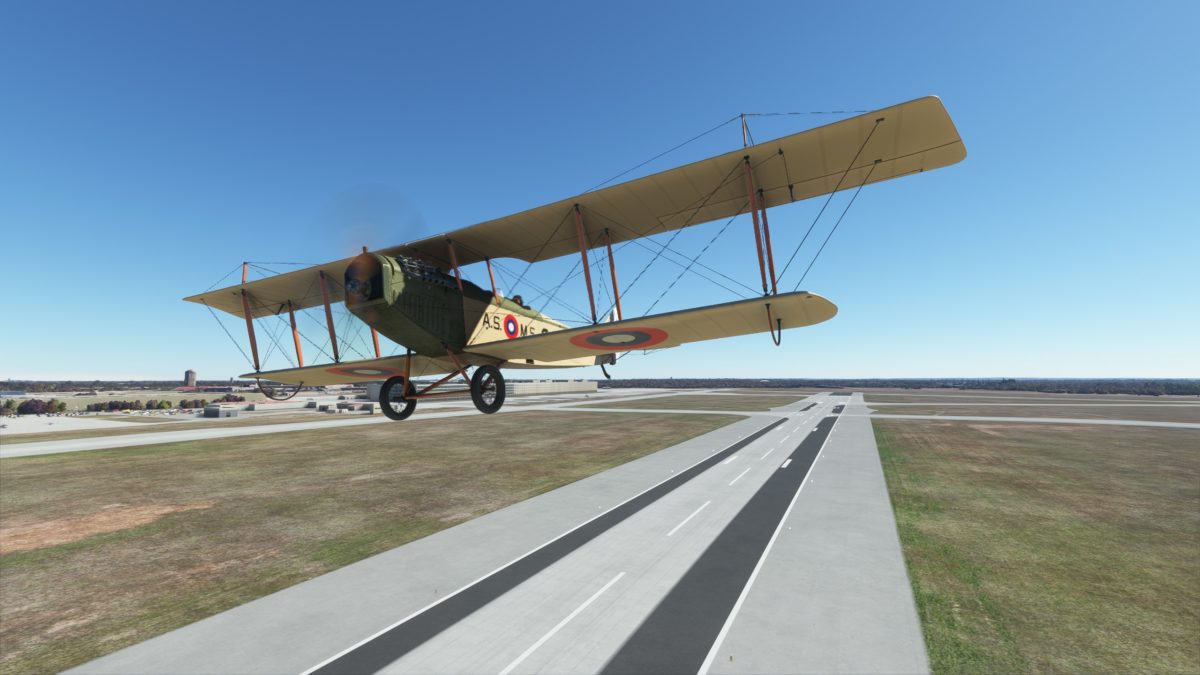
Over the next two years (1917-8), at Kelly Field alone over 250,000 men were assembled into 326 squadrons. The Air Mechanics school turned out 2,000 trained mechanics per month.
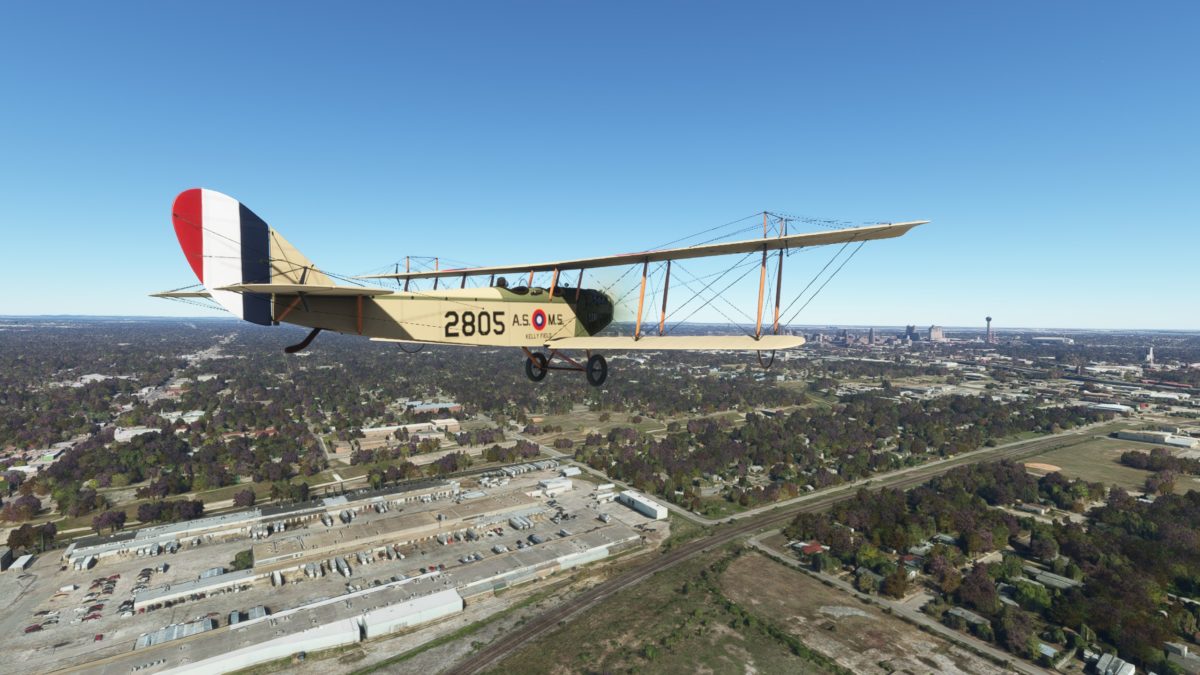
In 1917, the U.S. government forced Curtiss and the Wright Brothers to pool their patents and put their legal disputes aside, to allow production to ramp up.

To keep pace, the Curtiss factory in Buffalo, New York soon became the largest of its kind in the world. But even that wasn’t enough, and production had to licensed out to six other manufacturers across the country.

Although few of them made it to Europe before the war ended, 95% of American pilots trained during World War I learned to fly in a Curtiss Jenny.

And I bet more than a few of them couldn’t resist buzzing the Alamo, like I’m doing now.

Starting in early 1917, the Royal Flying Corps placed a large order with Curtiss for a special variant of JN-4 Jenny to be used for training British pilots in Canada.

Manufactured in Toronto, these became known as “Canucks”, and about 1,200 were built. Some were even equipped with skis for winter weather training.

This particular plane, emblazoned with “To Hell with the Kaiser” and “Buy a Bond”, traveled across Canada in a campaign to promote war bond sales.

Despite the skis, winter weather in Canada was not conducive to flight training. After the U.S. entered the war in April 1917, it invited the Royal Flying Corps to Fort Worth, Texas for the winter of 1917-8 to perform training there.

Camp Taliaferro was a complex of three airfields – Hicks, Barron, and Bembrook Fields – forming a triangle around Fort Worth that trained 1,960 British and Canadian student pilots (plus over 4,000 ground crew) that winter.



This JN-4 Canuck flew out of Bembrook Field. Like the other two, this airfields no longer exists, so I’m flying over the suburban residential area where it was once located.

Learning to fly was dangerous: 39 officers and cadets were killed in training accidents at Camp Taliaferro, before the Royal Air Service departing back north in April 1918.

“Wop” May of Edmonton was a Canadian pilot who flew in World War I. He became an ace, and was flying the last plane chased by the Red Baron just before the latter was shot down.

After the war was over, he rented a JN-4 Canuck and opened Canada’s first airport in a pasture outside of Edmonton. He helped local police engage in the first manhunt for a fugitive criminal by plane.

In 1920, May teamed up with fellow aviator and war veteran George Gorman to found May-Gorman Aeroplanes to offer transportation into Canada’s remote north. It is considered Canada’s first airline.

Their inaugural flight, flown by May, was from Edmonton to Grande Prairie, which I’m approaching now.

It was an almost 300-mile flight over largely unmapped wilderness, with one refueling stop. It took two days, and really drilled home the challenge of flying cross-country in the Jenny.

Back in the United States, people were coming up with all sorts of innovative uses for the thousands of Jennies produced during the war.

In 1919, the Marines involved in the U.S. occupation of Haiti once again used Jennies to scout the landscape in search of rebel forces.

I’m here in northern Haiti, in the mountainous area around Grande Rivière du Nord, which was a base for local resistance to the U.S. occupation, which lasted from 1915 to 1934.

During one patrol, USMC pilot Lt. Lawson H. Sanderson fixed a rifle to the windshield of his Jenny and used it as an improvised bomb site to dive-bomb a group of rebels.

Sanderson’s bombs hit their target, making it one of the first successful dive-bombing attacks in history.

His Jenny nearly disintegrate from structural stress on pulling out of the dive, but his success led to more attempts and soon Sanderson was teaching dive-bombing tactics to his fellow pilots back in the U.S.

Previously in 1917, the U.S. Army, working with what later became Bell Labs, rigged a JN-4 Jenny with a wireless transmitter and receiver, giving birth to the very first plane-to-ground and plane-to-plane radio communications.

And on May 15, 1918, to great fanfare, Army 2LT George L. Boyle took off on the first U.S. Air Mail flight from Washington DC to New York (via Philadelphia) in a JN-4 Jenny.

The very first Air Mail flight didn’t go as planned. Without a compass, Boyle became disoriented and followed the wrong set of railroad tracks south instead of north. On realizing his mistake, he landed and broke his propeller, and the 140 lbs of mail he was carrying had to be trucked back to Washington.

The first U.S. Air Mail flight was honored by a postage stamp. But due to an error, the Curtiss Jenny on it was printed upside down. The “inverted Jenny” became THE most legendary and sought-after stamp among collectors, with one of them recently selling for $1.3 million.

Despite some initial hiccups, air mail – often flown in Jennies – soon became a regular service, linking the country together in unprecedented ways.

The vagaries of weather and navigation, however, still presented an ongoing danger – especially in the absence of modern instruments.
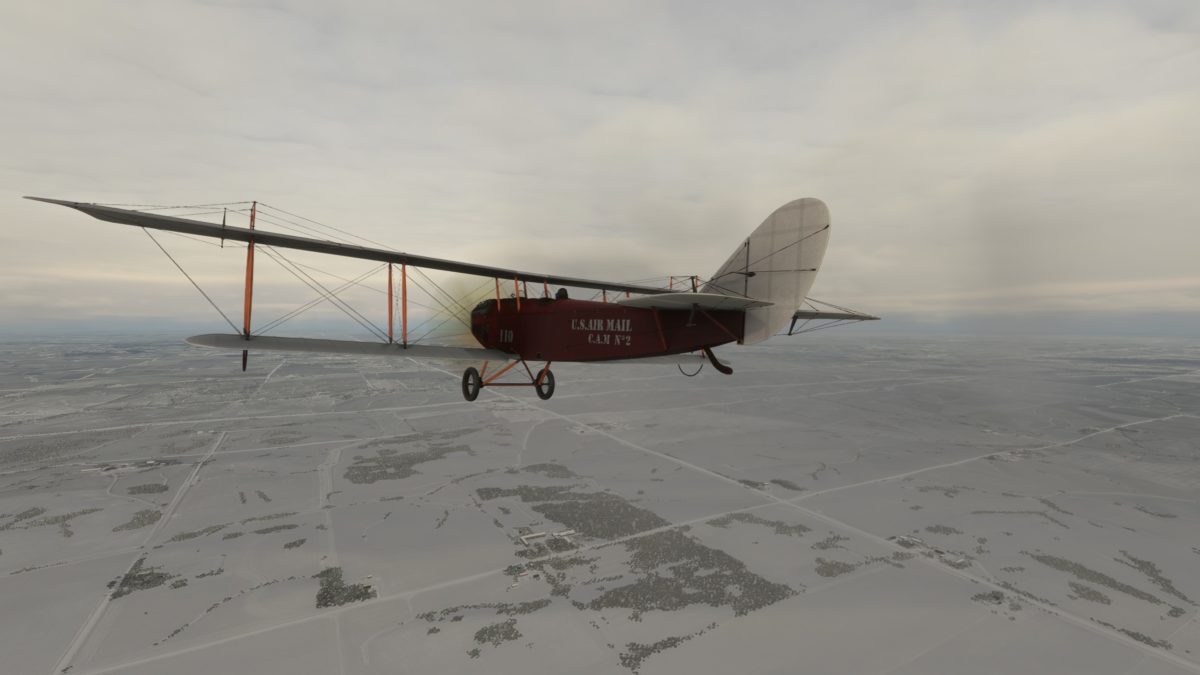
The pledge that “neither snow nor rain nor heat nor gloom of night stays these couriers from the swift completion of their appointed rounds” forced airmail pilots to fly in the face of often deadly conditions.
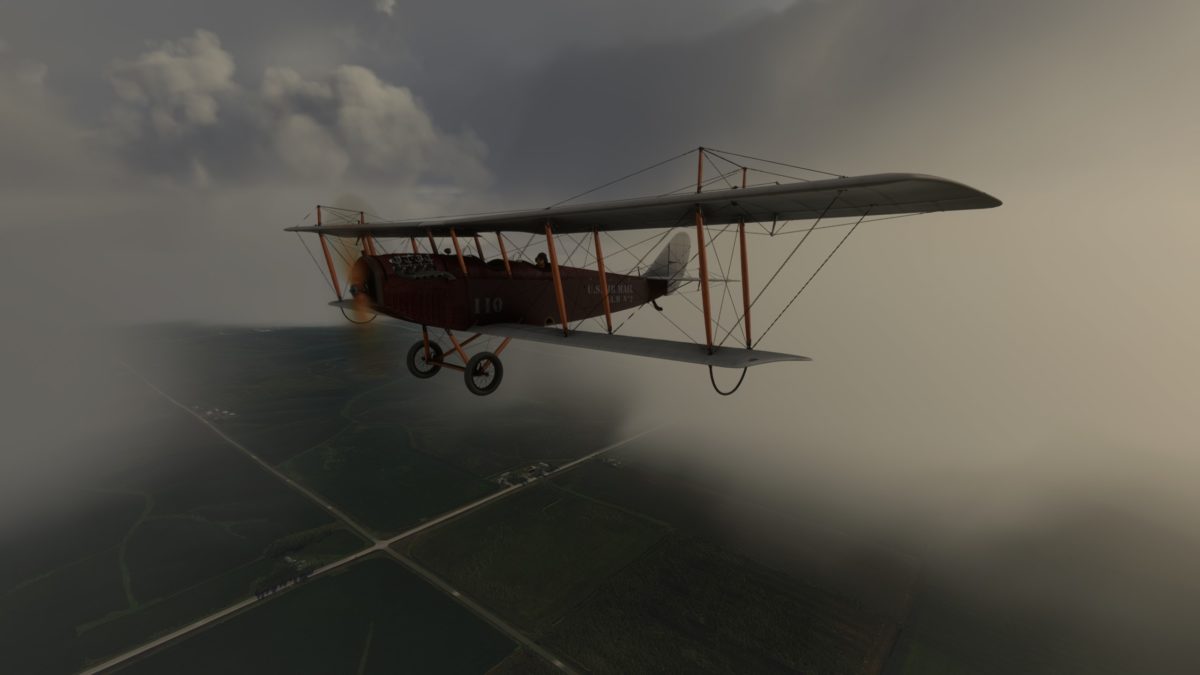
At least some Jennies were eventually equipped with magnetic compasses to find direction, like the one here:

But without an attitude indicator, turn coordinator, vertical speed indicator, or even an airspeed indicator, a pilot flying into clouds were completely blind, unable to tell up from down.

It was that much worse when strong updrafts, downdrafts, or sideways gusts could knock a fragile plane like the Jenny around like a rag doll in a storm.
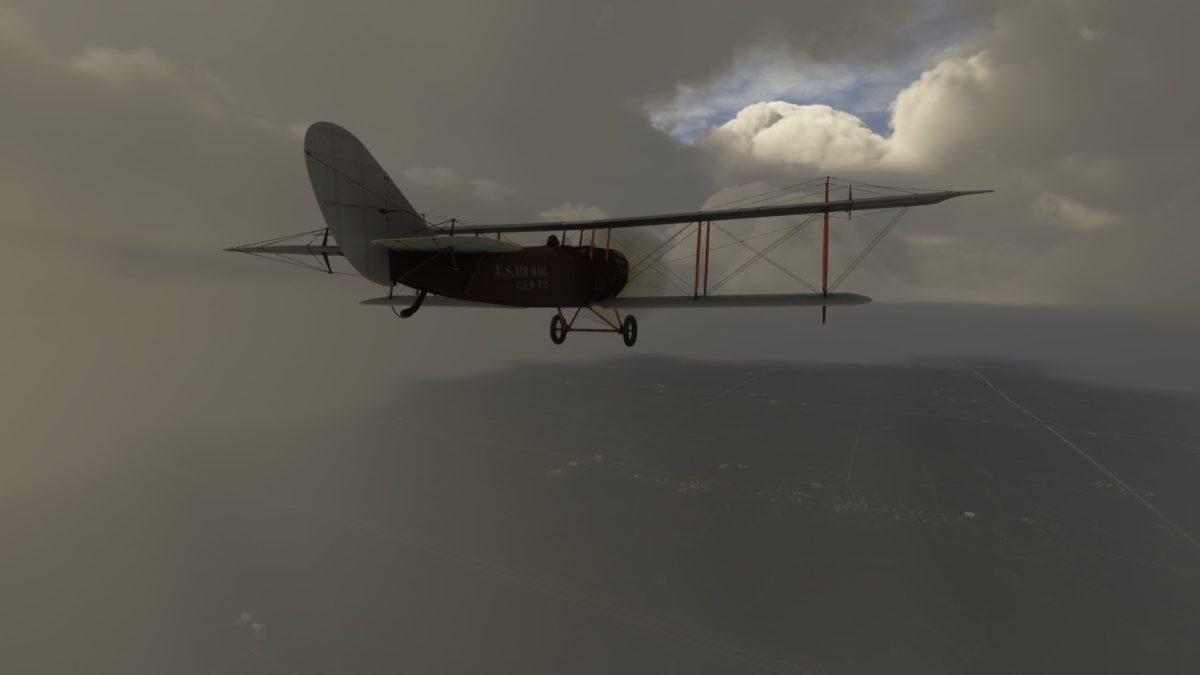
All pilots could do was try to fly “by the seat of the pants”, attempting to feel what the airplane was doing in the air – a notoriously unreliable and deceptive skill.

The same was true when airmail pilots flew at night, at a time when far fewer electric lights lit up the ground, especially over rural areas.

As a result, these earliest airmail pilots had a life expectancy of just 600 hours in the air. They were dubbed the “Suicide Club”.
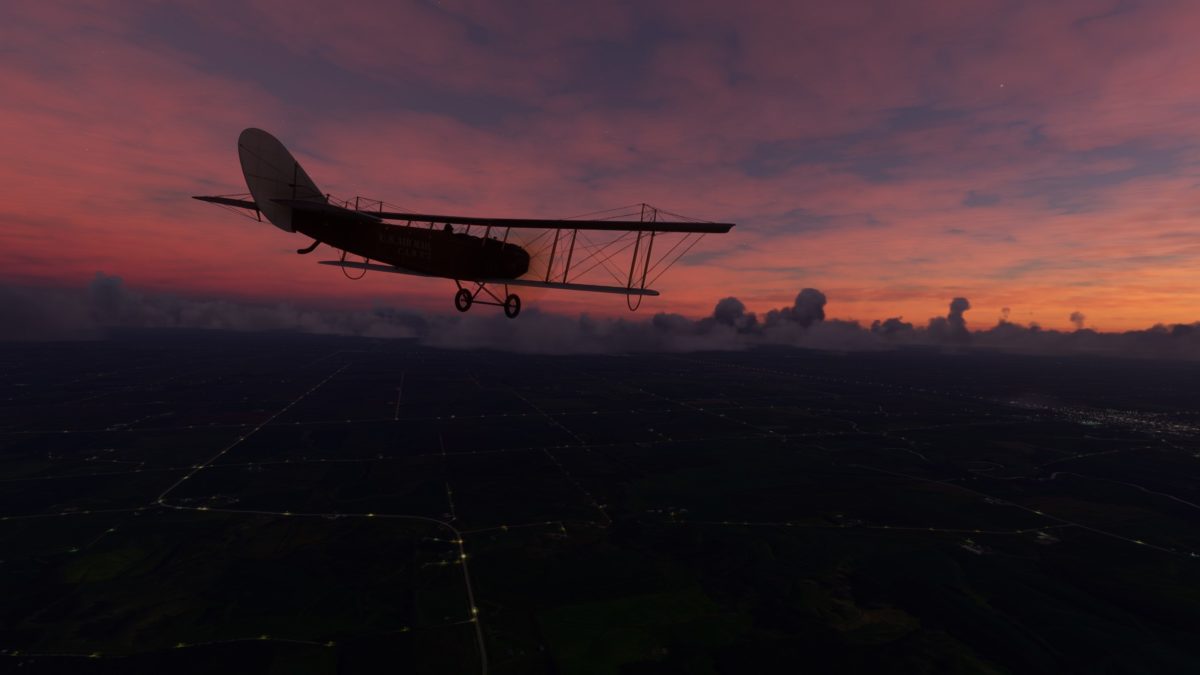
“Wild Bill” Hopson was one of the many pilots hired by the U.S. postal service who died flying the mail in those early days. His photo pretty much says it all.

After a year training in Texas with the U.S. Army, Lindbergh reverted to the Reserves and took a job as an airmail pilot flying the route from St. Louis to Chicago (in his case flying war-surplus De Havilland DH-4 biplanes, rather than Jennies).

He had to bail out by parachute twice when bad weather made it impossible for him to land, after running out of fuel. Fortunately, he survived both times.
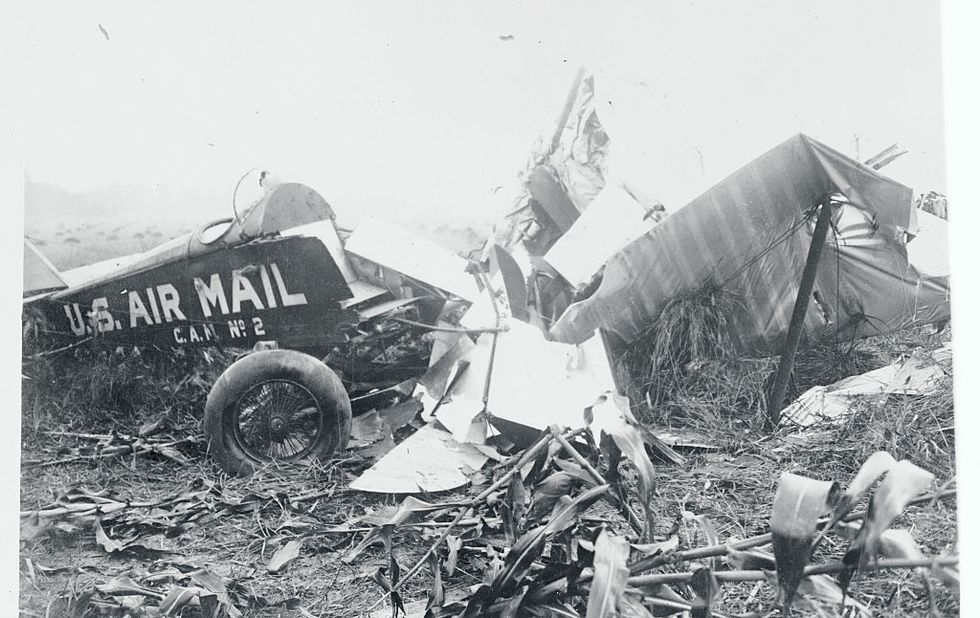
But let’s go back and join Lindbergh on his first flight in the Jenny, back in 1923. After two and half hours, I’ve arrived at his destination: Montgomery, Alabama.
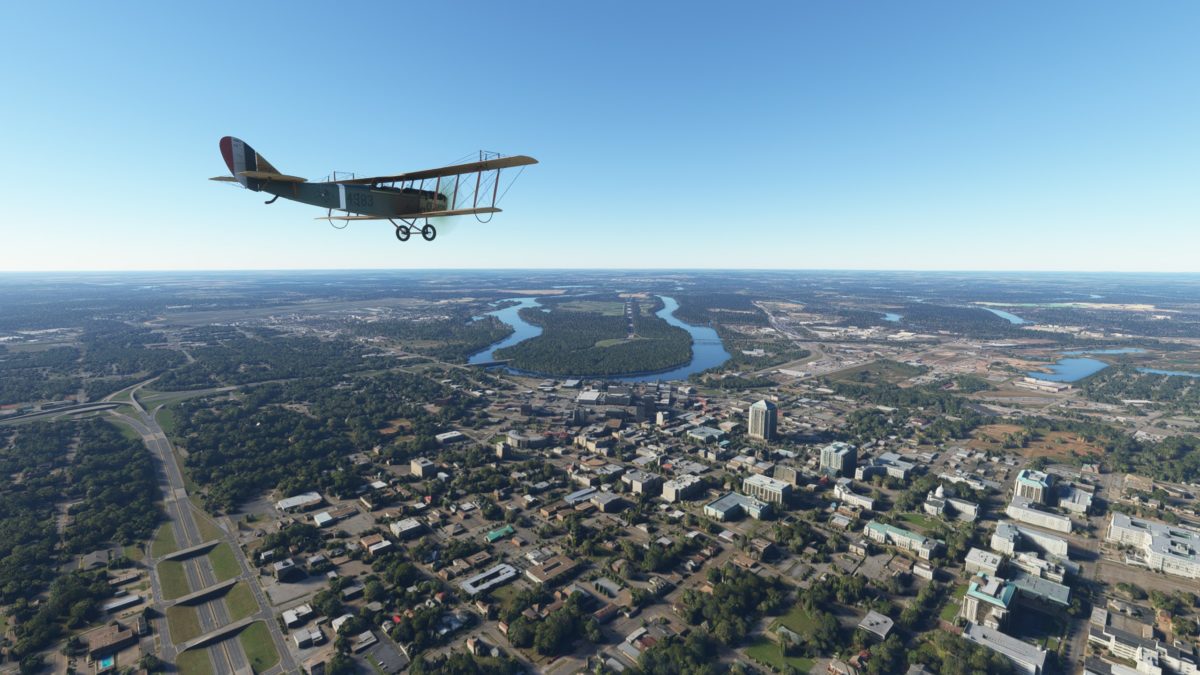
And, as predicted, I’m almost out of gas.

In the year before heading to Texas to join the Army, “Slim” would repaint his Jenny in eye-catching colors and travel all across the South and Midwest performing as a daredevil barnstormer.

Many pilots followed the same footsteps after the war, buying leftover Jennies and traveling across the country offering paid rides and performing stunts.

Sometimes they would show up to county fairs, but often they would just land at a local farmhouse and offer the people there a thrilling (and entirely unexpected) opportunity to fly.

For many Americans, seeing or even flying in a Jenny was their first-ever experience with aviation.
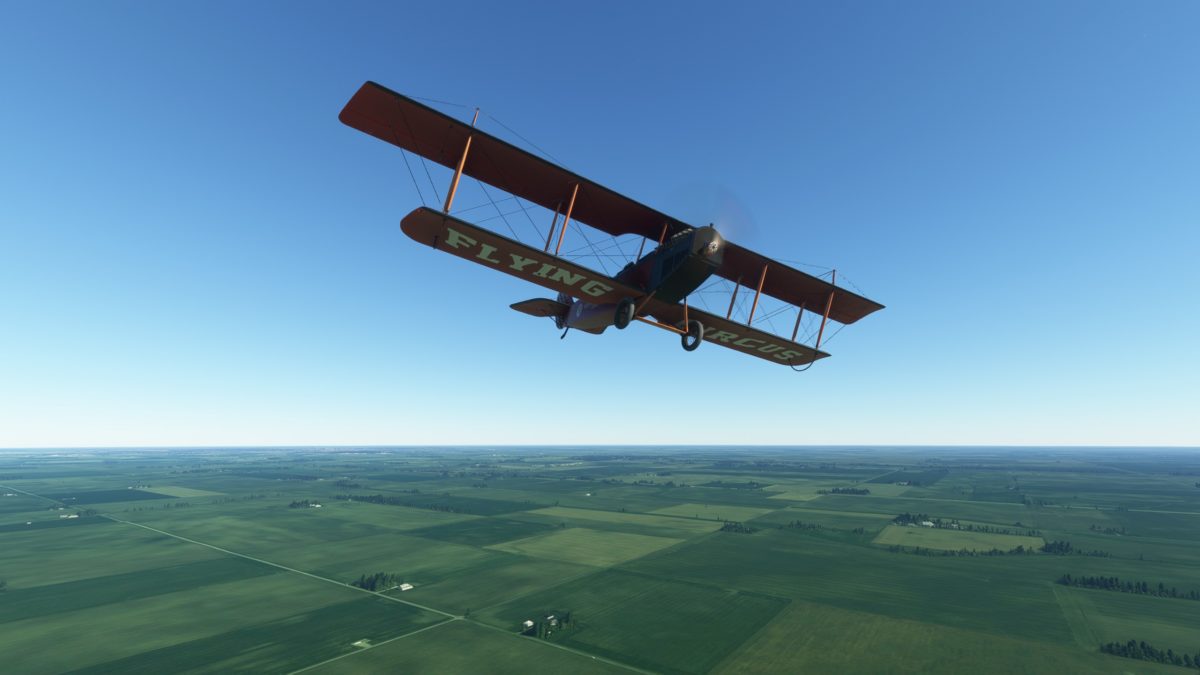
A handful of them were so inspired that they went on to become pilots themselves.

Of course, the name “barnstormer” comes from these pilots’ penchant for diving full-tilt at barns to thrill passengers and spectators.

Their sometimes-deadly antics were portrayed in the 1975 film “The Great Waldo Pepper”, starring Robert Redford.
The airplane in that movie was actually an earlier Curtiss J-1, and is preserved on display at the WACO Museum in Creve Coeur, Missouri.

One of the most famous and successful of the early barnstormers was Earl S. Daugherty.

Daugherty was born in Iowa and caught the flying bug early, in 1911. He was the 87th person in the country to acquire a pilot’s license.

I’m taking off from modern-day Long Beach Airport (KLGB), south of Los Angeles, because he actually founded the airport in 1919. Named Daugherty Field, it became the base for his aerobatic shows.

Rather than travel the country, Daugherty stayed put in southern California, where he entertained crowds along the beach and began performing stunts for Hollywood’s burgeoning movie industry.

He set up the city’s first flight school. It was there, in 1920, that Amelia Earhart took her first airplane ride and fell in love with flying.

In 1923 Daugherty, dubbed “the King of Aviation”, got married in a sky-high wedding ceremony while piloting his plane over Long Beach.

Sadly, in 1928 Daughter was performing a standard series of stunts when his wing buckled and his airplane crash. He and his two passengers were killed. He was 42.

Before he constructed his own airfield, Daugherty – and all other pilots – used to use Long Beach itself as their landing strip. So I’ll attempt a landing there in his memory.

The modern berms crisscrossing the sand make it tricky, and tipped me over on my first attempt. But I tried again, successfully.

Another famous barnstormer of that era was a woman named Lillian Boyer, who performed in this Jenny.

Lillian wasn’t a pilot herself. She was a waitress in Nebraska who was invited by two of her customers to come on an airplane ride.

On her second ride, she climbed out on the wing … and never looked back.

She began training with Bill Brock, a World War I pilot and barnstormer. Over the next few years, she performed in 352 shows in 41 states and Canada. In addition to parachute jumps, her specialty was climbing from a speeding automobile to an airplane.

If barnstorming sounds dangerous, it was. One industry almanac claimed that these daredevils accounted for 2/3 of all air fatalities in 1924.

To rein in these dangerous stunts, Congress passed and President Coolidge signed the 1926 Air Commerce Act. It set up federal rules for testing and licensing pilots, certifying the airworthiness of aircraft, and establishing safety rules.

The new rules forced Lillian Boyer into retirement in 1928. She lost all her money in the 1929 stock market crash, but married and lived to the age of 88, passing away in 1989.

Their era may have been over, but the death-defying barnstormers – most of them flying war-surplus Curtiss Jennies – left an enduring mark on aviation.

Back over Montgomery with 21-year-old Charles Lindbergh, it’s time to bring our journey to an end.

The next four years would see Lindbergh barnstorm across America, train as an Army flier, defy death as an airmail pilot and – to everyone’s surprise – become world famous as the first person to cross the Atlantic solo. The last is another story for another time.

But I hope this brief journey has helped explain how the Curtiss JN-4 Jenny helped lay the foundation for that epic crossing, and introduced America to the airplane.

The U.S. Army Air Service stopped flying the Curtiss Jenny in 1926. In total, over 6,800 were built. Only seven are currently flying in the U.S. today, but their legacy remains.

Leave a Reply